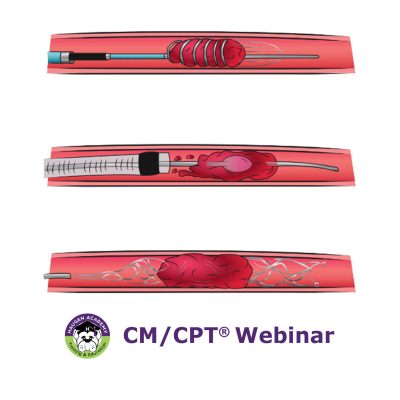This page addresses follow-up questions and additional information pertinent to our webinar
Vascular Interventional Radiology Coding: A Practical Approach Part 2.
** The coding information and guidance are valid at the time of publishing. Learners are encouraged to research
subsequent official guidance in the areas associated with the topic as they can change rapidly.
Q: Which code(s) is/are reported if infusion therapy is started and ends on the same date of service?
A: When infusion therapy is started and ends on the same date of service, report only code 37211 (arterial)/37212 (venous). Code 37214 for cessation of infusion therapy cannot be assigned with codes 37211/37212 for the same date of service.
Q: Is there ever a time when it is appropriate to report a diagnostic angiography code with modifier 59 along with Y-90 radioembolization?
A: Diagnostic angiography at the time of Y-90 radioembolization is very rare. Yttrium-90 (Y-90) has a half-life of 2.7 days and is a costly radioactive substance. Because of its short shelf life and high cost, hospitals special order it specific to the patient. As a result, you will see a patient come in a week or two prior to the planned Y-90 session for diagnostic imaging and mapping (e.g., technetium-99 [TC-99] MAA mapping). Once the mapping is complete, the provider, in concert with a nuclear physicist, determines the appropriate dosage for ordering. The patient is then brought back later for embolization. Some providers will say that they have to inject contrast and do “diagnostic” imaging to make sure nothing has changed since the previous study, which is unlikely within a couple of weeks. Diagnostic angiography would be warranted on the Y-90 encounter if there was a complication during the procedure that warranted additional diagnostic imaging, or if the patient had another cancer treatment, such as conventional chemotherapy or radiation therapy, between the mapping procedure and the Y-90 embolization. We recommend exercising caution when assigning diagnostic imaging with embolization codes because this code pairing generates an NCCI edit and the application of modifier 59 to bypass the edit could put a provider or facility at risk when payers perform data mining looking for trends.
Q: What is Tc-99 mapping and why is it done?
A: Technetium-99 (Tc-99) is a radioactive tracer that is commonly used prior to radioembolization to simulate where radioactive elements will be delivered during Y-90 embolization. Since embolization is a “kill” procedure designed to kill off tumors with an arterial supply, it’s also important to ensure that the procedure doesn’t inadvertently kill a necessary organ, such as the liver. In a mapping procedure, Tc-99 is injected into the arteries where radioembolization is expected to take place and the provider maps out the projected Y-90 embolization procedure. During this procedure, the provider may also embolize collateral arteries to prevent radiation from targeting the wrong area.
Looking for additional information on this topic?

Kristi Pollard, RHIT, CCS, CPC, CIRCC, AHIMA-Approved ICD-10-CM/PCS Trainer
Director of Coding Quality & Education
Kristi is the Director of Coding Quality & Education with more than 25 years of industry experience; she is responsible for the development of web-based, instructor-led, and webinar training materials; conducting training in ICD-10-CM/PCS and CPT; and performing DRG and APC audits. Kristi has an extensive background in coding education and consulting and is a national speaker and published writer on topics related to ICD-10 and CPT coding and code-based reimbursement. She has designed and developed training programs for inpatient and outpatient hospital-based coding, with a focus on vascular interventional radiology, interventional cardiology, orthopedics, and obstetrics.




0 Comments